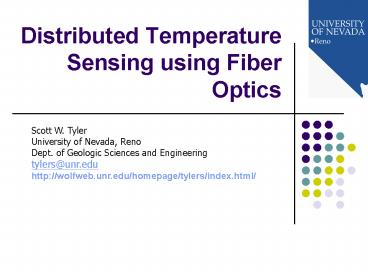Distributed Temperature Sensing using Fiber Optics - PowerPoint PPT Presentation
1 / 18
Title: Distributed Temperature Sensing using Fiber Optics
1
Distributed Temperature Sensing using Fiber Optics
Scott W. Tyler University of Nevada, Reno Dept.
of Geologic Sciences and Engineering tylers_at_unr.ed
u http//wolfweb.unr.edu/homepage/tylers/index.htm
l/
2
What is Distributed Temperature Sensing (DTS)
- The measurement of temperature (and) using only
the properties of a fiber optic cable. - The fiber optic cable serves as the thermometer,
with a laser serving as the illumination source. - Measurements of temperature every 1-2 meters for
as long as 30 km can be resolved, every 1-60
minutes, with temperature resolution of
0.01-0.5oC.
3
How Does it Work?
- Rayleigh, Raman and Brillouin scattering all
occur as light is passed through a fiber optic
cable. - Raman scattering is produced by inelastic
collisions of photons with atoms or molecules
within the fiber optic cable. If a photon loses
energy to the fiber, the scattered wavelength is
longer (Stokes Signal) if a scattered photon
gains energy from interactions, its energy is
larger and therefore its wavelength is shorter
(anti-Stokes Signal).
4
From Agilent, Inc.
- The Raman wavelengths are predictable and
symmetric. - The anti-Stokes (energy gaining) is strongly
temperature dependant, but the Stokes is
relatively independent of the temperature of the
colliding molecule. - The temperature of the scatterer is calculated
from the ratio of the anti-Stokes/Stokes
Intensity.
5
- Currently used in fire monitoring, oil pipeline
monitoring, high tension electrical transmission
cables, down hole monitoring of oil production,
dam seepage. - Cable lengths up to 30 km
- Resolution of Temperature every 1-2 meters!
- Temperature accuracy up to 0.01 oC
6
Advantages of DTS
- The cable serves as the measuring device
- Fiber optic cable is relatively inexpensive
(0.50-10/meter) and robust (more on that
later!) and have small thermal inertia. - Once installed, continuous measurements do NOT
disturb the fluid column (wells) or soils. - Very high resolution and long cables can provide
high density coverage of a landscape, lake, or
groundwater reservoir. - Installations can be temporary or permanent.
7
Instrument Response and Costs
- Tool costs range from 30K-60K
- Cable 1K-10K/km
- Several manufacturers interested in environmental
applications.
30K Instrument, 2 m resolution
8
Traditional Applications
- Geothermal Well Logging
- Circulation in boreholes, fracture mapping,
continuous borehole flowmeters - Limnology and fluid column monitoring
9
Sakaguchi and Matsushima (2000) detected
fractures in geothermal wells during Injection,
and showed growth of steam front.
10
Circulation in Mine Shafts(Selker, Stekjal,
Zeman, Tyler and Lockington)
- Circulation in flooded Czech mines
- Thermal and salinity stratification
- Double diffusive steps clearly present
- DTS produced a very high resolution data without
disturbance to the fluid column
Steps in both T and S occur over lt1 m
11
The Revolutionary or High Spatial Resolution
Applications
- Groundwater inflows to streams and estuaries.
(see Selker et al, WRR and Day-Lewis et al., EOS) - High spatial and temporal resolution snow/ground
interface temperatures, ground freezing and snow
melt. - Very high spatial resolution of lake
stratification and mixing. - Fish habitat monitoring and thermal regime
restoration efficacy.
12
Mapping GW Inflows in Streams
- DTS allows continuous measure of stream
temperatures to identify groundwater inflows - Diehl Temp changes allow calculation of gw flux.
From Selker et al., 2006
13
Role of Tidal Forcing on Ground Water
- 500 m cable installed in SF Bay to monitor
estuary temps. - Cost 900 for 500 m armored cable
- 500 spatial data points every 5 minutes with no
data loggers!
14
Installing fiber optic along the channel
15
Measuring Spatial Structure of Snowmelt
- Snow pack temperature experiment currently in
place at Mammoth, CA. - 500 m DTS cable laid to measure ground/snow
interface temperature. - High winds relocated the cable several times
before the snow fell.
16
Issues and the Future
- Instrument costs and power requirements are
coming down. - Expensive cables are needed for high pressure
installations. - Surface placement can put the cable at risk from
breakage and rodents, and reuse can be
challenging. - Cables can be repaired AND cable manufacturers
are working with Agilent, Lios and Sensornet for
improved cables for environmental. - The future looks bright. UNR will be campaigning
a tool in April-May 2007.
17
Recent Hydrology-Related Publications
- Selker, J. S., L. Thévenaz, H. Huwald, A. Mallet,
W. Luxemburg, N. van de Giesen, M. Stejskal, J.
Zeman, M. Westhoff, M. B. Parlange (2006),
Distributed fiber-optic temperature sensing for
hydrologic systems, Water Resour. Res., 42,
W12202, doi10.1029/2006WR005326. - Selker, J.S., N. van de Geisen, M. Poolman, W.
Luxemburg and M. Parlange, In Press, Fiber Optics
Open Window on Stream Dynamics, Geophysical
Research Letters. - AGU NS24A MCS220 Tuesday 1600h
- NS24A-02 INVITED Monitoring Submarine
Ground-Water Discharge Using a Distributed
Temperature Sensor, Waquoit Bay, Massachusetts
Day-Lewis et al.
18
Sensornet DTS Halo Unit, Preliminary































